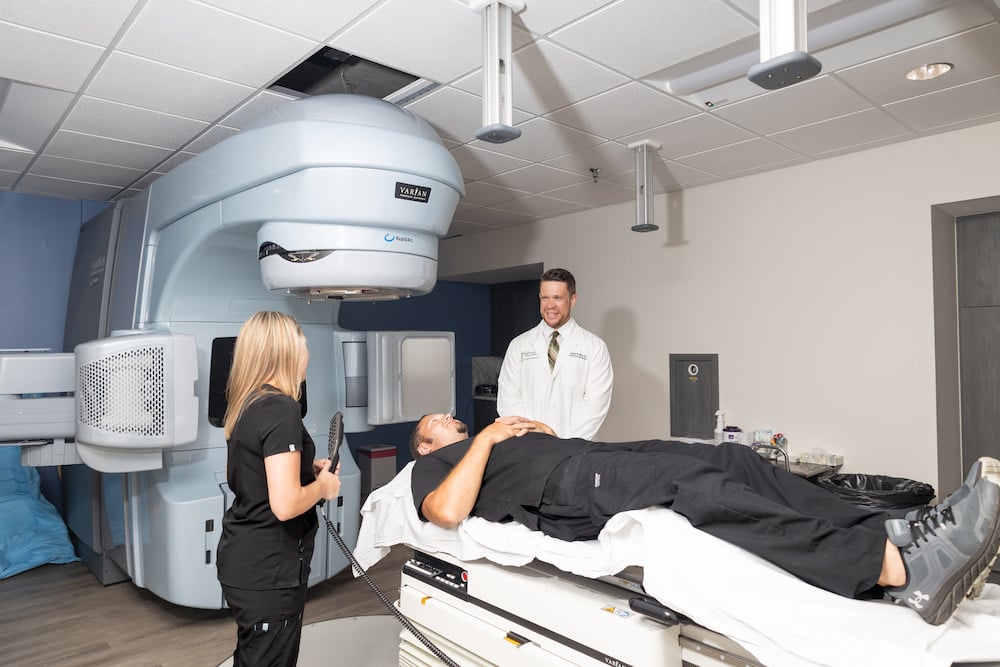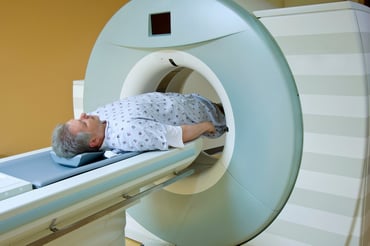
Treatments for prostate cancer continue to improve, which are giving men better survival rates and an improved quality of life after a prostate cancer diagnosis. Your prostate cancer treatment plan may include radiation therapy, one of the most commonly used treatments for cancer, including prostate cancer. There are several different types of radiation therapy used for prostate cancer including external beam radiation therapy, internal radiation therapy called brachytherapy, and proton therapy.
Proton beam therapy is a newer type of external radiation therapy surrounding tissues. It uses proton particles instead of X-rays, which can deliver a higher dose of radiation to different parts of the tumor. This results in less damage to surrounding tissues compared to IMRT radiation therapy.
How does the oncologist determine which is right for each patient?
How Radiation Therapy is Used to Treat Prostate Cancer
Radiation therapy (also called radiotherapy) can treat almost every type of cancer. It works by damaging the cancer cell’s DNA, which stops cells from growing and dividing.
A versatile cancer treatment, radiotherapy can be your primary treatment or used before surgery to shrink tumors, making them easier to surgically remove. It may also be used after surgery, to destroy any remaining cancer cells in the area. The treatment plan for prostate cancer can include both internal radiation (seeds) and external beam radiation therapies. For some men this allows them to avoid surgery to remove the prostate and the side effects that come with it.
Related Read: What Every Man Should Know About Radiation Therapy for Prostate Cancer
Brachytherapy: Treating Prostate Cancer from Inside the Body
Internal radiation therapy uses tiny seeds or pellets loaded with a radioactive source and implanted inside you, on or near the tumor. Implantation requires a procedure that includes anesthesia and surgery to place them. Once they’re in place you won’t notice them. The radioactive seeds remain in the prostate and eventually break down over time, releasing radiation to the targeted areas.
For a period of time, you will emit a low dose of radiation which isn’t harmful to most people although you might limit the time you spend around children or anyone who is pregnant until the radioactive material has broken down. Your cancer care team will help you know what’s safe for you and your loved ones.
External Beam Radiation Therapy for Prostate Cancer
External beam radiation therapy (EBRT) uses a linear accelerator to deliver radiation to the specific area where the cancer is located to kill cancer cells. This is a highly precise process with measures taken to protect the anus and the bladder from damage caused by the radiation beams in the same area as the prostate. Imaging is used to precisely pinpoint the location and shape of the radiation beams, which deliver the radiation from several directions and at varying intensities, based on what the patient needs.
Two technologies are commonly used for prostate cancer:
Intensity Modulated Radiation Therapy (IMRT): This is a precise technology used to target prostate cancer tumor cells. To be most accurate the radiation oncologist will use CT scans or other three-dimensional (3-D) images taken of the patient to build the treatment plan. This technology also allows the beams of radiation to vary in angle and intensity so that some areas receive more radiation than others. This reduces the damage to nearby tissue and organs.
Treatments can last from 4-8 weeks depending on the dose that can be delivered to the patient. Hypofractionated radiation will be used when possible to reduce the total time radiation treatments are needed.
Stereotactic Body Radiation Therapy (SBRT): Used more often for those who cannot have prostate removal surgery, this type of radiation delivers high doses of radiation using several beams of varying intensity. The total length of treatment is shorter than IMRT.
How Does Proton Therapy Treat Prostate Cancer?
Proton beam therapy, another type of radiation, that uses protons instead of X-rays to kill cancer. Also noninvasive, the nature of proton therapy is that it releases the cancer-killing energy only at the tumor site compared to radiation which releases some of the energy before reaching the tumor. Targeting causes less damage to surrounding healthy tissues and organs, which can cause fewer side effects and complications.
Currently, the use of proton therapy is limited because of its high cost and lack of access to specialized proton treatment facilities.
How Do Radiation and Proton Therapies Compare?
The best treatment for you depends on the type of cancer you have and which treatment will provide the best outcome for your specific needs. The total treatment time of proton therapy compared to radiation therapy is about the same.
Although proton therapy can deliver a higher dose of radiation directly at the tumor, it directs 60% less radiation to healthy tissues, which causes fewer and milder side effects than standard radiation. Efforts to reduce damage to healthy cells using radiation therapy is always a focus for the treatment team to be sure you’re getting the right dose, without over treating.
Standard radiation therapy has a slightly higher risk of causing secondary cancers. Proton therapy appears to reduce that risk.
Standard radiation is most often used on aggressive, fast-growing tumors because treatment sessions can be scheduled quickly, when time counts. It’s also more likely to be recommended with early-stage cancer that only needs monitoring.
Proton therapy is not as widely accessible as standard radiation because it requires a specialized proton treatment facility. Its high cost is also a consideration.
Proton therapy isn’t used if you have a hip joint replacement or a heart pacemaker.
Side Effects of Radiation and Proton Therapies
Most people have some side effects from external radiation and proton therapy. They are about the same side effects for both, although the severity varies according to the type, stage and location of your cancer, the dosage you receive, your age, and overall health.
Short-term side effects usually go away after your treatment ends. They can include:
- Fatigue
- Nausea/vomiting or diarrhea
- Hair loss
- Skin changes over the radiation site (with EBRT)
- Dry mouth, problems swallowing
- Cough, shortness of breath
What’s New in Prostate Cancer Treatment Research?
Researchers and medical professionals continue to study and improve prostate cancer treatment technology. Advancements have been made in high-dose rate brachytherapy, cryoablation, high-intensity ultrasound, and better imaging techniques to assist with staging, monitoring and follow-up.
New technologies, medications, and treatment protocols are being tested in clinical trials.
What’s Right for Your Prostate Cancer Treatment Plan?
The good news is that prostate cancer has a high rate of survival with 97% of all patients living at least five years after diagnosis. The earlier it’s detected, the better the outcome. The oncologist will prepare a recommended treatment plan, often in coordination with the urologist, based on your stage, Gleason score, grade and overall health condition.
It’s a good idea to share your treatment preferences and get answers to all your questions about treatment before you begin.
Prostate Cancer Treatment in the Greater Atlanta Area
If you or a loved one received a prostate cancer diagnosis, it’s a good time to review your treatment options and create a plan.
Because there are quite a few visits for external radiation therapy, it’s helpful to choose a cancer specialist close to your home or work. Prostate cancer patients in the greater Atlanta area can receive the latest radiation treatment close to home at any of our centers in Conyers, Covington, Decatur, and Snellville, Georgia.



